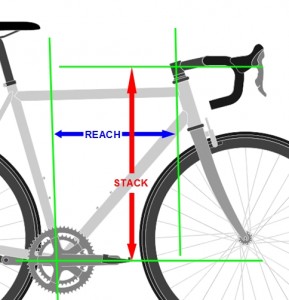Stack and Reach
Ten years ago Dan Empfield, co-founder of the well-known triathlon portal slowtwitch.com, first introduced the concepts of ‘stack’ and ‘reach’. Reason enough for us to take a closer look at this measurement method – which is hardly used in the German-speaking area:
The background:
The reason for introducing this new method in 2003 was the new way in which triathlon machines were developed. The ever more special construction of triathlon frames made it impossible to unambiguously measure the traditional distances such as toptube-length, seat tube-length and –angle. Almost all producers introduced a different method on how these distances should be measured for their frames. This made it more complicated for both bike dealers and bikefitters to recommend a frame geometry. They were left to comparing apples with oranges. That’s why Dan Empfield searched for a new method to make triathlon frames comparable again. After the development of Stack & Reach, Cervelo (with their developer Damon Rinard, who we already got to know as innovator from previous projects) and Trek were the first producers considering and integrating the method. By now these values are also frequently used for describing the geometries of road bike- and MTB-frames.
The concepts:
STACK – refers to the vertical distance between the bottom bracket and the head tube top
REACH – refers to the horizontal distance between these two points
The method:
Basically when using this method X/Y coordinates are detected and the distance between them is calculated. The frame is considered in a coordinate system where the x-axis describes the horizontal distance, whereas the y-axis refers to the vertical distance. Now the bottom bracket can be defined exactly by its X/Y position. The same is true for the position of the head tube top. The difference of the respective x-values gives the REACH value while the difference of the y-values results in the STACK value.
Why are these values helpful?
As mentioned, this method improves the comparability of geometries if the construction of the frames differs. That is why the current triathlon machines with their shortened rear end, the integrated seat posts and stems are the best example for the usefulness of the Stack & Reach method. The fewer adjustment possibilities the frame offers, the more important is a match between frame-geometry and rider-anatomy.
An example: If we detect that the present frame is too long during a triathlon fitting we can calculate the recommended reach value for a new frame. Additionally, the stack value helps determining the matching saddle/ handlebar differential, so that few spacers need to be used. Important to note: The Stack & Reach values must not be regarded in isolation. The cockpit with the components handlebar form (having its own additional reach), stem-length and -angle should necessarily be considered when recommending a new frame or fitting an existing one.
Author: Daniel Schade
Source: Slowtwitch



